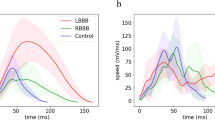Abstract
A spatiotemporal 3D left ventricular (LV) motion model was developed to extract regional function for intra left ventricular dyssynchrony (intra-LVD). A finite element model was divided into the standard 17 segments. Temporal interpolation was performed by using periodic control theoretic smoothing splines. Intra-LVD was assessed in terms of systolic dyssynchrony index (SDI) by measuring the dispersion of time to reach peak regional ejection fraction (TPREF). We compared two patient groups: 300 asymptomatic (A: 139M/161F, mean age: 61±9.7 yrs) and 105 patients with myocardial infarction (P: 81M/24F, mean age: 63±10.2 yrs). Consistent regional variation in TPREF was observed in the A group, with the basal septal segments having later TPREF. Omitting these segments significantly reduced the SDI values in both groups (P < .001), but improved the statistical differences between cohorts (P: 8.46±4.15% vs A: 6.03±2.93% with basal septal segments; P: 7.24±4.08% vs A: 4.22±2.27% without). The mean Mahalanobis distance of the P group to the distribution of the A group was increased from 2.66±4.63% to 4.99±8.26% (P < .001). These results strongly suggest that basal septal regions should be removed from intra-LVD indices, to provide better discrimination between the two cohorts.
Access this chapter
Tax calculation will be finalised at checkout
Purchases are for personal use only
Preview
Unable to display preview. Download preview PDF.
Similar content being viewed by others
References
Bild, D.E., Bluemke, D.A., et al.: Multi-ethnic study of atherosclerosis: objectives and design. Am. J. Epidemiol. 156(9), 871–881 (2002)
van Bommel, R.J., Tanaka, H., et al.: Association of intraventricular mechanical dyssynchrony with response to cardiac resynchronization therapy in heart failure patients with a narrow QRS complex. Eur. Heart J. 31(24), 3054–3062 (2010)
Cerqueira, M.D., Weissman, N.J., et al.: Standardized myocardial segmentation and nomenclature for tomographic imaging of the heart: a statement for healthcare professionals from the Cardiac Imaging Committee of the Council on Clinical Cardiology of the American Heart Association. Circulation 105(4), 539–542 (2002)
Chalil, S., Stegemann, B., et al.: Intraventricular dyssynchrony predicts mortality and morbidity after cardiac resynchronization therapy: a study using cardiovascular magnetic resonance tissue synchronization imaging. J. Am. Coll. Cardiol. 50(3), 243–252 (2007)
Chen, J., Henneman, M.M., et al.: Assessment of left ventricular mechanical dyssynchrony by phase analysis of ECG-gated SPECT myocardial perfusion imaging. J. Nucl. Cardiol. 15(1), 127–136 (2008)
Faletra, F.F., Conca, C., et al.: Comparison of eight echocardiographic methods for determining the prevalence of mechanical dyssynchrony and site of latest mechanical contraction in patients scheduled for cardiac resynchronization therapy. Am. J. Cardiol. 103(12), 1746–1752 (2009)
Fonseca, C.G., Backhaus, M., et al.: The Cardiac Atlas Project –an imaging database for computational modeling and statistical atlases of the heart. Bioinformatics 27(16), 2288–2295 (2011)
Helm, R.H., Leclercq, C., Faris, O.P., et al.: Cardiac dyssynchrony analysis using circumferential versus longitudinal strain: implications for assessing cardiac resynchronization. Circulation 111(21), 2760–2767 (2005)
Hunter, P.J., Pullan, A.J., Smaill, B.H.: Modeling total heart function. Annu. Rev. Biomed. Eng. 5, 147–177 (2003)
Kadish, A.H., Bello, D., et al.: Rationale and design for the Defibrillators to Reduce Risk by Magnetic Resonance Imaging Evaluation (DETERMINE) trial. J. Cardiovasc Electrophysiol 20(9), 982–987 (2009)
Kano, H., Egerstedt, M., et al.: Periodic smoothing splines. Automatica 44(1), 185–192 (2008)
Kapetanakis, S., Kearney, M.T., et al.: Real-time three-dimensional echocardiography: a novel technique to quantify global left ventricular mechanical dyssynchrony. Circulation 112(7), 992–1000 (2005)
Padeletti, L., Perini, A.P., Gronda, E.: Cardiac resynchronization therapy: the issue of non-response. Heart Fail. Rev. 17(1), 97–105 (2012)
Young, A.A., Cowan, B.R., et al.: Left ventricular mass and volume: fast calculation with guide-point modeling on MR images. Radiology 216(2), 597–602 (2000)
Author information
Authors and Affiliations
Editor information
Editors and Affiliations
Rights and permissions
Copyright information
© 2013 Springer-Verlag Berlin Heidelberg
About this paper
Cite this paper
Suinesiaputra, A. et al. (2013). Intraventricular Dyssynchrony Assessment Using Regional Contraction from LV Motion Models. In: Ourselin, S., Rueckert, D., Smith, N. (eds) Functional Imaging and Modeling of the Heart. FIMH 2013. Lecture Notes in Computer Science, vol 7945. Springer, Berlin, Heidelberg. https://doi.org/10.1007/978-3-642-38899-6_54
Download citation
DOI: https://doi.org/10.1007/978-3-642-38899-6_54
Publisher Name: Springer, Berlin, Heidelberg
Print ISBN: 978-3-642-38898-9
Online ISBN: 978-3-642-38899-6
eBook Packages: Computer ScienceComputer Science (R0)




